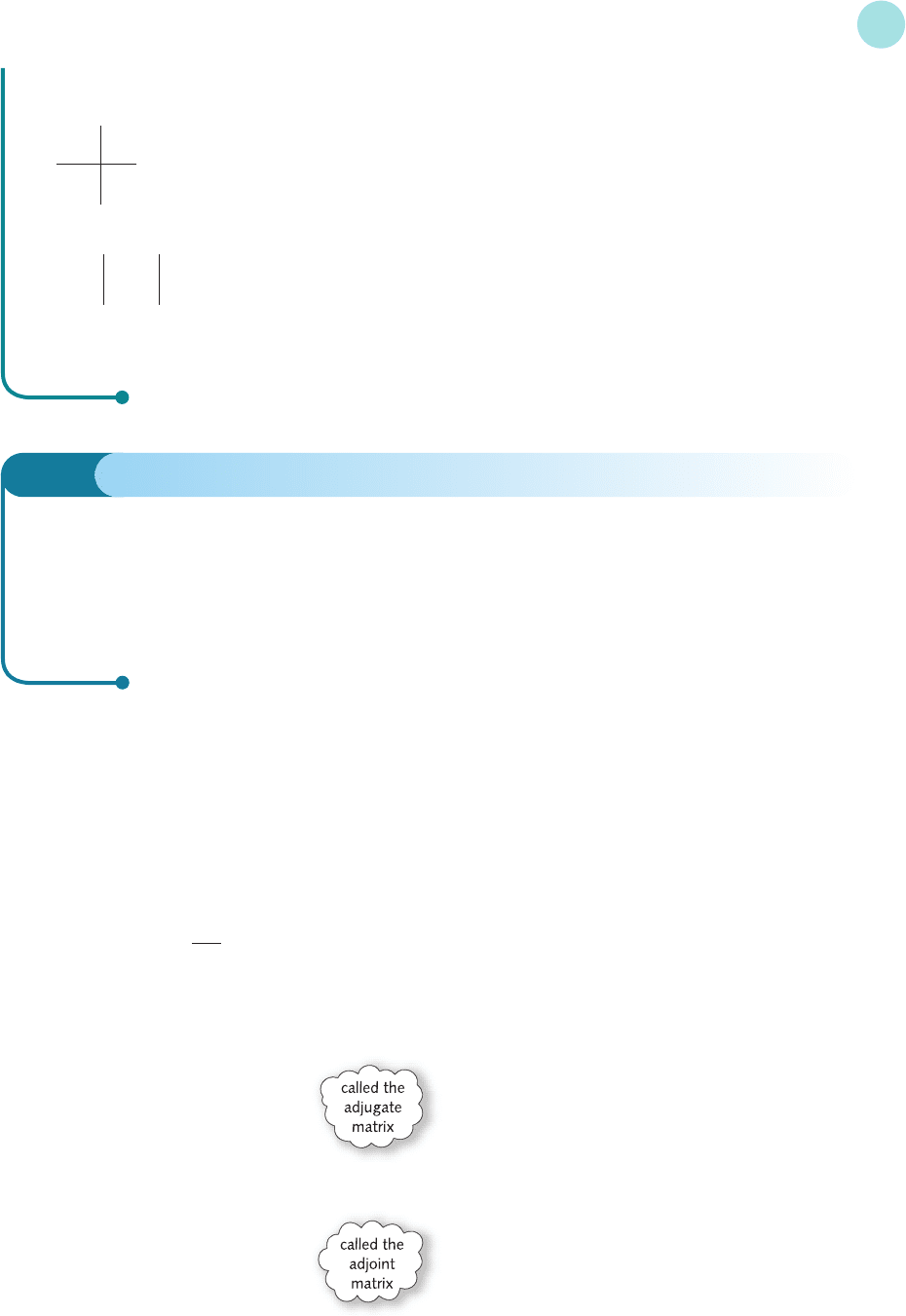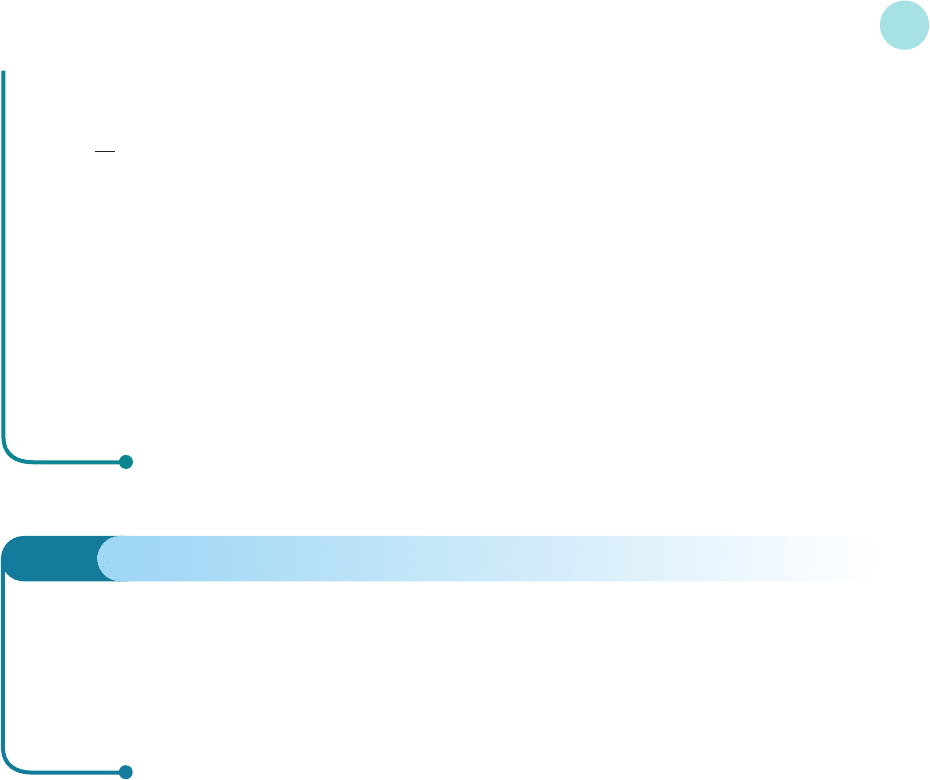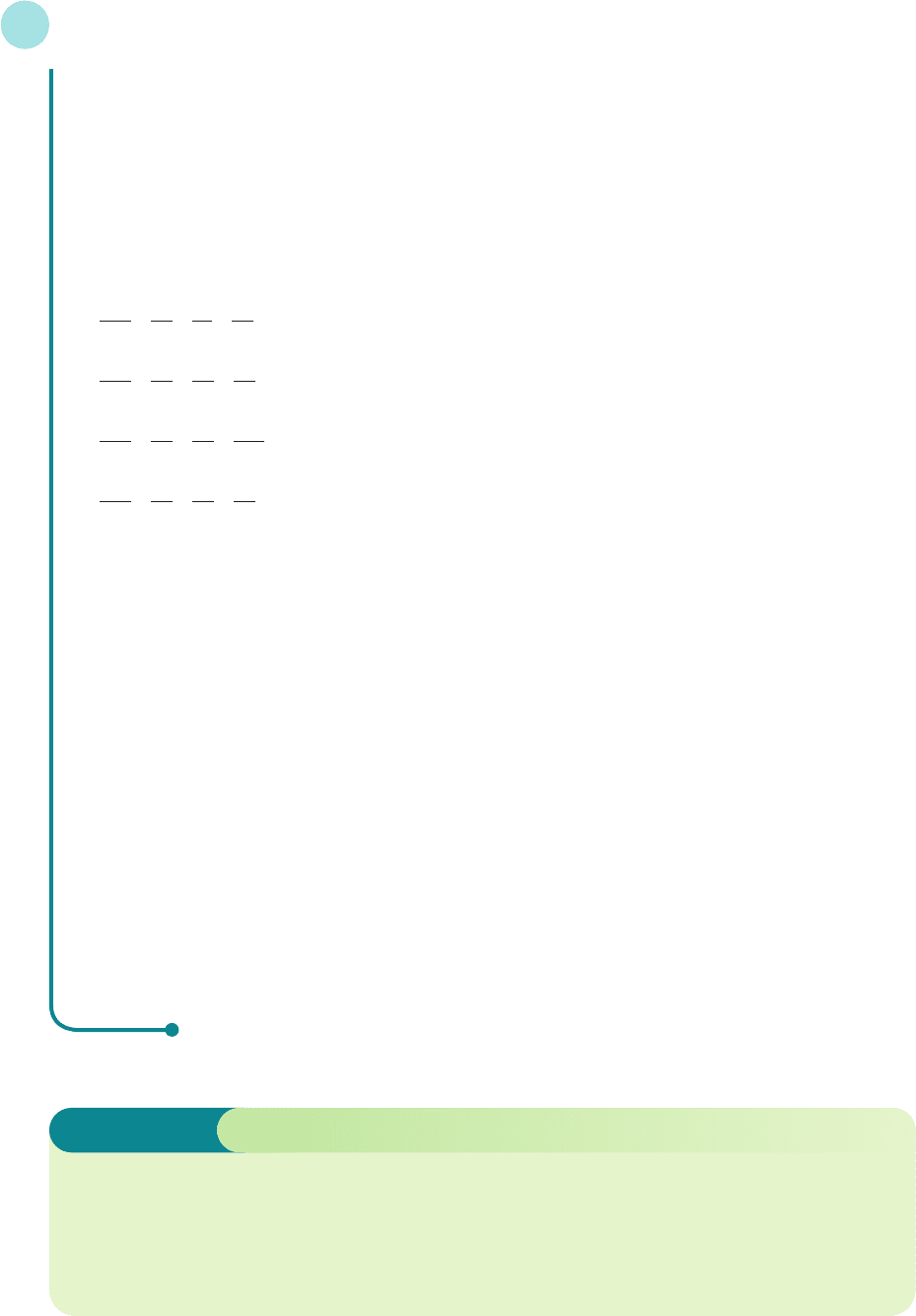Jacques I. Mathematics for Economics and Business
Подождите немного. Документ загружается.


Matrices
480
we see that a
23
is in a minus position. In other words,
A
23
=−
=−(a
11
a
32
− a
12
a
31
)
=−a
11
a
32
+ a
12
a
31
a
11
a
12
a
31
a
32
Example
Find all the cofactors of the matrix
A =
Solution
Let us start in the top left-hand corner and work row by row. For cofactor A
11
, the element a
11
= 2 lies in the
first row and first column, so we delete this row and column to produce the 2 × 2 matrix
Cofactor A
11
is the determinant of this 2 × 2 matrix, prefixed by a ‘+’ sign because from the pattern
we see that a
11
is in a plus position. Hence
A
11
=+
=+(3(3) − 7(1) )
= 9 − 7
= 2
For cofactor A
12
, the element a
12
= 4 lies in the first row and second column, so we delete this row and col-
umn to produce the 2 × 2 matrix
Cofactor A
12
is the determinant of this 2 × 2 matrix, prefixed by a ‘−’ sign because from the pattern
we see that a
12
is in a minus position. Hence
J
K
K
L
+−+
−+−
+−+
G
H
H
I
J
K
K
L
241
437
213
G
H
H
I
37
13
J
K
K
L
+−+
−+−
+−+
G
H
H
I
J
K
K
L
241
437
213
G
H
H
I
J
K
K
L
241
437
213
G
H
H
I
MFE_C07b.qxd 16/12/2005 10:45 Page 480

7.2 • Matrix inversion
481
A
12
=+
=−(4(3) − 7(2) )
=−(12 − 14)
= 2
We can continue in this way to find the remaining cofactors
A
13
=+ =−2
A
21
=− =−11
A
22
=+ =4
A
23
=− =6
A
31
=+ =25
A
32
=− =−10
A
33
=+ =−10
24
43
21
47
41
37
24
21
21
23
41
13
43
21
47
23
Practice Problem
4 Find all the cofactors of the matrix
A =
J
K
K
L
133
143
134
G
H
H
I
We are now in a position to describe how to calculate the determinant and inverse of a
3 × 3 matrix. The determinant is found by multiplying the elements in any one row or column
by their corresponding cofactors and adding together. It does not matter which row or column
is chosen; exactly the same answer is obtained in each case. If we expand along the first row of
the matrix
A =
we get
det(A) = a
11
A
11
+ a
12
A
12
+ a
13
A
13
J
K
K
L
a
11
a
12
a
13
a
21
a
22
a
23
a
31
a
32
a
33
G
H
H
I
MFE_C07b.qxd 16/12/2005 10:45 Page 481

Matrices
482
Similarly, if we expand down the second column, we get
det(A) = a
12
A
12
+ a
22
A
22
+ a
32
A
32
The fact that we get the same answer irrespective of the row and column that we use for expan-
sion is an extremely useful property. It provides us with an obvious check on our calculations.
Also, there are occasions when it is more convenient to expand along certain rows or columns
than others.
Example
Find the determinants of the following matrices:
A = and B =
Solution
We have already calculated all nine cofactors of the matrix
A =
in the previous example. It is immaterial which row or column we use. Let us choose the second row. The
cofactors corresponding to the three elements 4, 3, 7 in the second row were found to be −11, 4, 6, respec-
tively. Consequently, if we expand along this row, we get
= 4(−11) + 3(4) + 7(6) = 10
As a check, let us also expand down the third column. The elements in this column are 1, 7, 3 with co-
factors −2, 6, −10, respectively. Hence, if we multiply each element by its cofactor and add, we get
1(−2) + 7(6) + 3(−10) = 10
which is the same as before. If you are interested, you might like to confirm for yourself that the value of 10
is also obtained when expanding along rows 1 and 3, and down columns 1 and 2.
The matrix
B =
is entirely new to us, so we have no prior knowledge about its cofactors. In general, we need to evaluate all
three cofactors in any one row or column to find the determinant of a 3 × 3 matrix. In this case, however,
we can be much lazier. Observe that all but one of the elements in the second row are zero, so when we
expand along this row we get
det(B) = b
21
B
21
+ b
22
B
22
+ b
23
B
23
= 0B
21
+ 2 B
22
+ 0B
23
= 2B
22
J
K
K
L
1075
020
273
G
H
H
I
241
437
213
J
K
K
L
241
437
213
G
H
H
I
J
K
K
L
1075
020
273
G
H
H
I
J
K
K
L
241
437
213
G
H
H
I
MFE_C07b.qxd 16/12/2005 10:45 Page 482

7.2 • Matrix inversion
483
Hence B
22
is the only cofactor that we need to find. This corresponds to the element in the second row and
second column, so we delete this row and column to produce the 2 × 2 matrix
The element b
22
is in a plus position, so
B
22
=+ =20
Hence,
det(B) = 2B
22
= 2 × 20 = 40
10 5
23
J
K
K
L
1075
020
273
G
H
H
I
Practice Problem
5 Find the determinants of
A = and B =
[Hint: you might find your answer to Practice Problem 4 useful when calculating the determinant of A.]
J
K
K
L
270 −372 0
552 201 0
999 413 0
G
H
H
I
J
K
K
L
133
143
134
G
H
H
I
The inverse of the 3 × 3 matrix
A =
is given by
A
−1
=
Once the cofactors of A have been found, it is easy to construct A
−1
. We first stack the cofactors
in their natural positions
Secondly, we take the transpose to get
J
K
K
L
A
11
A
21
A
31
A
12
A
22
A
32
A
13
A
23
A
33
G
H
H
I
J
K
K
L
A
11
A
12
A
13
A
21
A
22
A
23
A
31
A
32
A
33
G
H
H
I
J
K
K
L
A
11
A
21
A
31
A
12
A
22
A
32
A
13
A
23
A
33
G
H
H
I
1
|A|
J
K
K
L
a
11
a
12
a
13
a
21
a
22
a
23
a
31
a
32
a
33
G
H
H
I
MFE_C07b.qxd 16/12/2005 10:45 Page 483

Matrices
484
Finally, we multiply by the scalar
to get
A
−1
=
The last step is impossible if
|A |=0
because we cannot divide by zero. Under these circumstances the inverse does not exist and the
matrix is singular.
J
K
K
L
A
11
A
21
A
31
A
12
A
22
A
32
A
13
A
23
A
33
G
H
H
I
1
|A |
1
|A |
Advice
It is a good idea to check that no mistakes have been made by verifying that
A
−1
A = I and AA
−1
= I
Example
Find the inverse of
A =
Solution
The cofactors of this particular matrix have already been calculated as
A
11
= 2, A
12
= 2, A
13
=−2
A
21
=−11, A
22
= 4, A
23
= 6
A
31
= 25, A
32
=−10, A
33
=−10
Stacking these numbers in their natural positions gives the adjugate matrix
The adjoint matrix is found by transposing this to get
J
K
K
L
2 −11 25
24−10
−26−10
G
H
H
I
J
K
K
L
22−2
−1146
25 −10 −10
G
H
H
I
J
K
K
L
241
437
213
G
H
H
I
MFE_C07b.qxd 16/12/2005 10:45 Page 484

7.2 • Matrix inversion
485
In the previous example the determinant was found to be 10, so
A
−1
==
As a check
A
−1
A ===I ✓
AA
−1
===I ✓
J
K
K
L
100
010
001
G
H
H
I
J
K
K
L
1/5 −11/10 5/2
1/5 2/5 −1
−1/5 3/5 −1
G
H
H
I
J
K
K
L
241
437
213
G
H
H
I
J
K
K
L
100
010
001
G
H
H
I
J
K
K
L
241
437
213
G
H
H
I
J
K
K
L
1/5 −11/10 5/2
1/5 2/5 −1
−1/5 3/5 −1
G
H
H
I
J
K
K
L
1/5 −11/10 5/2
1/5 2/5 −1
−1/5 3/5 −1
G
H
H
I
J
K
K
L
2 −11 25
24−10
−26−10
G
H
H
I
1
10
Practice Problem
6 Find (where possible) the inverses of
A = and B =
[Hint: you might find your answers to Practice Problems 4 and 5 useful.]
J
K
K
L
270 −372 0
552 201 0
999 413 0
G
H
H
I
J
K
K
L
133
143
134
G
H
H
I
Inverses of 3 × 3 matrices can be used to solve systems of three linear equations in three
unknowns. The general system
a
11
x + a
12
y + a
13
z = b
1
a
21
x + a
22
y + a
23
z = b
2
a
31
x + a
32
y + a
33
z = b
3
can be written as
Ax = b
where
A = x = b =
The vector of unknowns, x, can be found by inverting the coefficient matrix, A, and multiply-
ing by the right-hand-side vector, b, to get
x = A
−1
b
J
K
K
L
b
1
b
2
b
3
G
H
H
I
J
K
K
L
x
y
z
G
H
H
I
J
K
K
L
a
11
a
12
a
13
a
21
a
22
a
23
a
31
a
32
a
33
G
H
H
I
MFE_C07b.qxd 16/12/2005 10:45 Page 485

Matrices
486
Throughout this section, we have concentrated on 2 × 2 and 3 × 3 matrices. The method
described can be extended to larger matrices of order n × n. However, the cofactor approach is
very inefficient. The amount of working rises dramatically as n increases, making this method
inappropriate for large matrices. The preferred method for solving simultaneous equations is
Practice Problem
7 Determine the equilibrium prices of three interdependent commodities that satisfy
P
1
+ 3P
2
+ 3P
3
= 32
P
1
+ 4P
2
+ 3P
3
= 37
P
1
+ 3P
2
+ 4P
3
= 35
[Hint: you might find your answer to Practice Problem 6 useful.]
Example
Determine the equilibrium prices of three interdependent commodities that satisfy
2P
1
+ 4 P
2
+ P
3
= 77
4P
1
+ 3 P
2
+ 7P
3
= 114
2P
1
+ P
2
+ 3 P
3
= 48
Solution
In matrix notation this system of equations can be written as
Ax = b
where
A = x = b =
The inverse of the coefficient matrix has already been found in the previous example and is
A
−1
=
so
==
The equilibrium prices are therefore given by
P
1
= 10, P
2
= 13, P
3
= 5
J
K
K
L
10
13
5
G
H
H
I
J
K
K
L
77
114
48
G
H
H
I
J
K
K
L
1/5 −11/10 5/2
1/5 2/5 −1
−1/5 3/5 −1
G
H
H
I
J
K
K
L
P
1
P
2
P
3
G
H
H
I
J
K
K
L
1/5 −11/10 5/2
1/5 2/5 −1
−1/5 3/5 −1
G
H
H
I
J
K
K
L
77
114
48
G
H
H
I
J
K
K
L
P
1
P
2
P
3
G
H
H
I
J
K
K
L
241
437
213
G
H
H
I
MFE_C07b.qxd 16/12/2005 10:45 Page 486

7.2 • Matrix inversion
487
based on the elimination idea that we described in Section 1.2. This is easily programmed, and
a computer can solve large systems of equations in a matter of seconds. We shall not pursue
this approach any further, since the practical implementation of this method requires an
understanding of the build-up of rounding errors on a computer. (The interested reader is
referred to any textbook on numerical analysis.) Instead, we describe how to use Maple to get
results, and we illustrate this with a simple 4 × 4 example.
Example
Solve the equations
2x
1
− x
2
+ 4x
3
+ 5x
4
=−17
x
1
+ 6x
2
+ 2x
3
− 4x
4
= 24
5x
1
+ 2x
2
− x
3
− 7x
4
= 40
3x
1
+ 2x
2
+ 2x
3
+ 6x
4
=−16
Solution
Before you can use Maple to solve problems involving matrices, it is necessary first to load the specialist lin-
ear algebra routines. You do this by typing:
with(linalg):
In matrix notation, the system can be written as
Ax = b
where
A = x = b =
To input the matrix A, you type
J
K
K
K
K
L
−17
24
40
−16
G
H
H
H
H
I
J
K
K
K
K
L
x
1
x
2
x
3
x
4
G
H
H
H
H
I
J
K
K
K
K
L
2 −14 5
162−4
52−1 −7
3226
G
H
H
H
H
I
MAPLE
>A:=array(1..4,1..4,[[2,–1,4,5],[1,6,2,–4],[5,2,–1,–7],[3,2,2,6]]);
To solve the linear equations all you have to do is to type
>linsolve(A,[–17,24,40,–16]);
MFE_C07b.qxd 16/12/2005 10:45 Page 487

Matrices
488
Maple responds with the solution
[2,1,0,–4]
so x
1
= 2, x
2
= 1, x
3
= 0, x
4
=−4.
Notice that Maple has solved the equations without explicitly showing the inverse on the screen. If you
need to see this, then just type
>C:=inverse(A);
which gives
The solution can also be found from this by working out A
−1
b. This is achieved by first creating the 4 × 1
right-hand side column matrix b by typing:
>b:=array(1..4,1..1,[[–17],[24],[40],[–16]]);
In Maple, the symbol for matrix multiplication is &* so we can find x by typing
>x:=C&*b;
Unfortunately, Maple rather unimaginatively responds with
x:=C&*b
To actually perform the calculation you need to evaluate this matrix product by typing
>evalm(x);
which produces the desired effect and yields the solution
J
K
K
K
K
L
2
1
0
−4
G
H
H
H
H
I
11
82
−2
41
−1
26
−32
533
−15
82
−1
41
3
26
148
533
11
82
−2
41
3
26
−73
533
4
41
6
41
−1
13
14
533
G
H
H
H
H
H
H
H
H
I
J
K
K
K
K
K
K
K
K
L
Cofactor (of an element) The cofactor of the element, a
ij
, is the determinant of the matrix
left when row i and column j are deleted, multiplied by +1 or −1, depending on whether
i + j is even or odd, respectively.
Determinant A determinant can be expanded as the sum of the products of the elements
in any one row or column and their respective cofactors.
Key Terms
MFE_C07b.qxd 16/12/2005 10:45 Page 488

7.2 • Matrix inversion
489
Identity matrix An n × n matrix, I, in which every element on the main diagonal is 1 and
the other elements are all 0. If A is any n × n matrix then AI = I = IA.
Inverse matrix A matrix, A
−1
with the property that A
−1
A = I = AA
−1
.
Non-singular matrix A square matrix with a non-zero determinant.
Singular matrix A square matrix with a zero determinant. A singular matrix fails to
possess an inverse.
Square matrix A matrix with the same number of rows as columns.
Practice Problems
8 Let
A = and B =
(1) Find
(a)
|A | (b) |B| (c) |AB|
Do you notice any connection between |A|, |B| and | AB|?
(2) Find
(a) A
−1
(b) B
−1
(c) (AB)
−1
Do you notice any connection between A
−1
, B
−1
and (AB)
−1
?
9 If the matrices
and
are singular, find the values of a and b.
10 Use matrices to solve the following pairs of simultaneous equations:
(a)
3x + 4y =−1 (b) x + 3y = 8
5x − y = 64x − y = 6
11 Calculate the inverse of
Hence find the equilibrium prices in the two-commodity market model given in Practice Problem 12
of Section 1.3.
12 For the commodity market
C = aY + b (0 < a < 1, b > 0)
I = cr + d (c < 0, d > 0)
J
K
L
−31
2 −9
G
H
I
J
K
L
2 b
3 −4
G
H
I
J
K
L
2 −1
3 a
G
H
I
J
K
L
10
24
G
H
I
J
K
L
21
51
G
H
I
MFE_C07b.qxd 16/12/2005 14:37 Page 489
